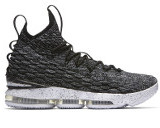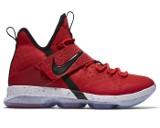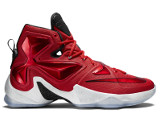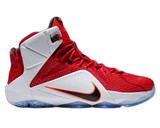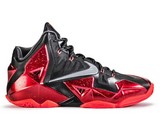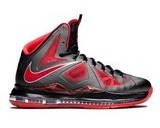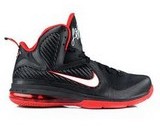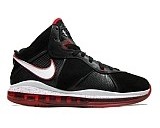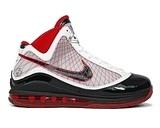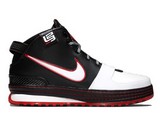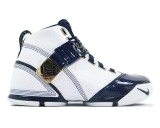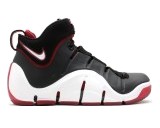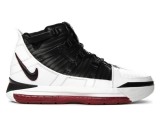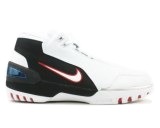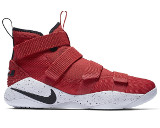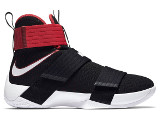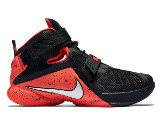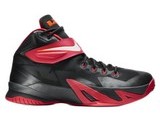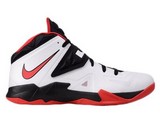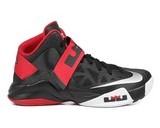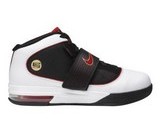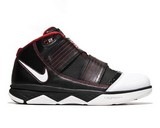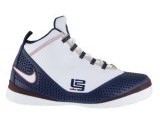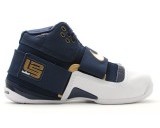Homepage > Reviews > Nike LeBron III
Note to the user: The NikeLeBron.net crew puts a lot of effort into running this website. That is the reason why instead of writing our own reviews we find the best ones for our readers. The author of this review is the one and only Professor K and it is the Solecollector.com property published here because the source is no longer available. All the photos and information are the property of their respective owners.
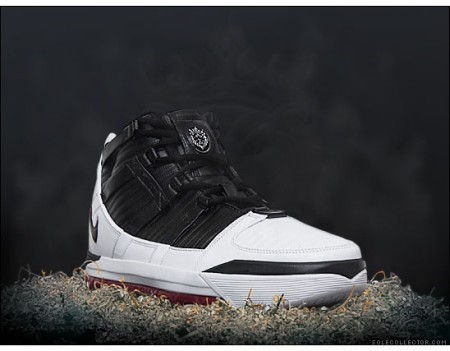 |
|---|
Full Metal Jacket
Like a precisely engineered part hewn from a solid block of aluminum, the Nike Zoom LeBron III feels like it’s meant to last and help you last over the course of not just one tough game, but an entire grueling season. But its durability and protection come with tradeoffs that may prove too weighty for some. |
Max-protect. That was the name given to an offensive line scheme devised by the Jacksonville Jaguars to try and slow the 2004 Pittsburgh Steelers’ defense, which led the League in sacks going into the teams’ week-12 match up. As today’s Steelers know only too well, an NFL-caliber starting quarterback is an invaluable commodity, so the Jaguars were willing to do whatever it took to protect their talented but mobility-challenged QB, Bryon Leftwich. In the Jag’s case that meant keeping extra players back to block on nearly every passing down, sacrificing offensive options for maximum protection, hence the name max-protect.
Jacksonville lost the game (Pittsburgh stole a one-point win on a 37-yard field goal with just 18-seconds left in regulation), but their unusual protection scheme succeeded in limiting the Steelers to just two sacks and, most importantly, left Leftwich standing to fight another day. Other teams around the league took notice and, from that point on, the new-look Steel Curtain saw a lot of max-protect, which limited the unit to a total of three sacks over the last four games of the regular season – that after the team had recorded a whopping 36 sacks up through their week-12 meeting with Jacksonville.
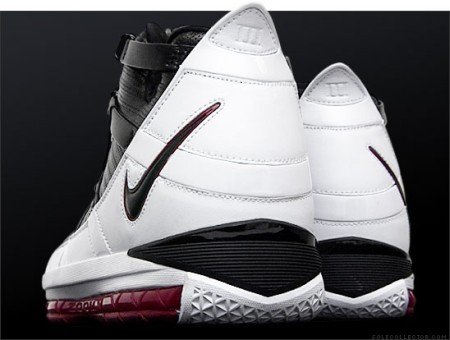 |
|---|
| Get Into Your Shell: A defining characteristic of the Nike Zoom LeBron III is its injection molded Pebax support shell, which wraps around and helps stabilize the whole of the rearfoot. As a semi-rigid structure, the shell acts as both an oversized heel counter and an anti-inversion device, helping prevent or, at the very least, mitigate the impact of a rolled ankle. The black clip at the base of the heel (which is made of thermoplastic urethane, or TPU for short) also helps stabilize things out back, while contributing a visual flourish that complements the black TPU bumper at the front of the shoe. |
Why the long diversion into the intricacies of offensive line stratagem? Well, aside from the fact that I have football on the brain these days, the concept of max-protect is an apt metaphor for what seems to have been the driving influence behind the design and development of the Nike Zoom LeBron III. In Nike’s case, the golden goose is not a promising second-year quarterback, but something even more precious: a gleaming, $90-million man-child by the name of LeBron James.
Overview
Now, Nike can’t ring James with a full-time security detail out on the court, but the company can apply its considerable financial and human resources towards the development of a shoe that does everything imaginable to protect its young phenom over the course of a grueling 82-game season (and the folks in Cleveland will be hoping that it’s longer still). And this is no easy feat; aside from the rigors of James’ job, his own freakish anatomy poses an enormous challenge. With nearly 250-pounds of muscle wrapped around a 6-foot, 9-inch frame, he has the size and strength of an NFL linebacker (I told you I have football on the brain), but matches it with a level of explosiveness and balletic agility generally reserved for high-flying NBA two-guards. James really is a player like no other, and his almost super-human aspect and abilities place ferocious demands on his footwear, which brings us back to the Zoom LeBron III.
Sharing a similar cushioning configuration – namely a Phylon midsole augmented with large-volume Zoom Air units reinforced by way of a Pebax shell (Pebax is a unique, high-performance resin that behaves something like a steroid-enhanced cross between rubber and plastic) – casual observers might dismiss the Zoom LeBron III as little more than a warmed-over rehash of its predecessor, the Zoom LeBron II. While anyone who’s logged serious on-court minutes in the much-loved II would likely be all for bringing that most excellent shoe back for another go-round, the Zoom LeBron III is, while not a revolutionary departure, a departure nonetheless. This latest offering in LeBron’s signature line exhibits its own distinct performance personality that some fans of the II will welcome and others not so much. Let’s start from the bottom and work on up.
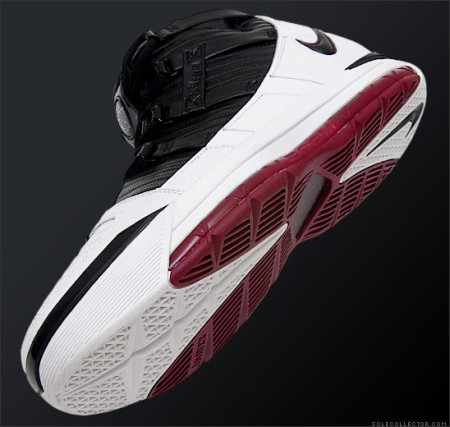 |
|---|
| Flex Time: The aggressive latitudinal and longitudinal flex grooves carved out of the Zoom LeBron III’s solid rubber outsole help the shoe deliver a surprisingly natural feel underfoot. Flexibility under the ball of the foot is an area in which the Zoom LeBron III clearly improves upon its predecessor. |
Look into the details
Of the few criticisms directed at the Zoom LeBron II the lion’s share concerned its traction, which was excellent outdoors and on clean indoor surfaces, but poor on dusty indoor courts. The Zoom LeBron III features a completely redesigned outsole intended to address that problem, but your mileage may vary. I found that the III’s traction trumped the II’s on courts that were generally well maintained, delivering squeak-inducing grip that enabled me to slash like O.J. and pull up like a valet at the Bellagio, but my experience on worn out wood was not so good. Basically, if the surface you ball on is more tarnish than varnish, you’ll spend more time sliding than slashing. To be fair, no shoe is going to provide glue-like grip in such conditions, but the Zoom LeBron III seems near bottom in this regard.
The Zoom LeBron III’s new outsole design does, however, unambiguously outperform its predecessor’s in one important respect: flexibility under the forefoot. Like the II, the Zoom LeBron III’s outsole is marked by a very deep longitudinal (meaning it goes from front-to-back) groove. Carving out the rubber of the outsole in this way allows the base of the shoe to more easily yield to the foot during lateral movement, resulting in a much more natural feel underfoot. But unlike the II, the III also features prominent latitudinal grooves, which deserve much of the credit for the new shoe’s perceptibly improved flexibility under the ball of the foot. Like the front-to-back carve-out, the side-to-side grooves allow the Zoom LeBron III to work more like a natural extension of your own flesh and blood and less like a stiff plank strapped to your dogs. But wait, there’s more – consideration for underfoot feel doesn’t stop at the outsole.
While the large-volume Zoom Air units at the heart of the Zoom LeBron III’s midsole are of the same thickness as those in its predecessor, the surrounding foam is thinner – right down to the polyurethane in the III’s molded sockliner. The difference is a matter of millimeters, but it’s immediately apparent when wearing the Zoom LeBron II on one foot and the III on the other. The latter provides noticeably improved court feel under both the forefoot and heel, which is a boon for active players at any position. And it’s not only the midsole that’s been put on a diet – the Pebax cage that reinforces the LeBron III’s Zoom bags has also been thinned out, if only by a hair. According to Ken Link, senior footwear designer at Nike Basketball and design lead for both the Zoom LeBron II and III, long-term testing of the former indicated that its cage was actually “over-engineered.” That means it was beefier than it needed to be and, as such, it’s been shaved slightly in the III, allowing the cage to be both more flexible and more responsive.
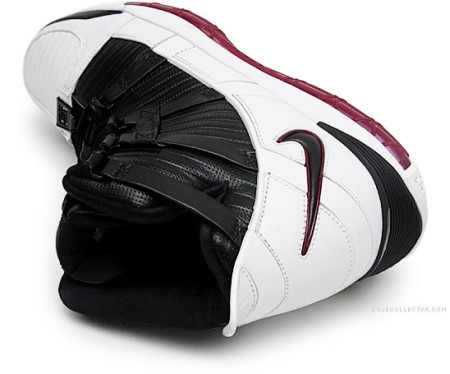 |
|---|
| Contain the Beast: The support straps that mark the upper of the Zoom LeBron III give it an exposed, almost inside-out appearance that seems to subtly echo the look of the legendary Air Jordan XI. In the case of the LeBron III, however, the straps are not fully stitched down onto the upper, allowing them a measure of freedom to shift and slide in synchrony with the foot. The result is excellent fit that keeps your dogs in place, yet manages to avoid an artificial, cast-like feel around the foot. |
Performance
Speaking of responsive, the aforementioned large-volume Zoom Air units in the III keep LeBron’s signature line at the bleeding edge of all-around cushioning performance. The irresistible cocktail of impact protection, cushioning response and stability introduced in last season’s LeBron II returns, but the system as a whole is made even more intoxicating thanks to the improvements in flexibility and court feel detailed above. And while I generally don’t recommend Zoom-based shoes to bigs for fear that their low-profile air bags will bottom-out, the thickness of the Zoom units in the LeBron III combined with their surrounding Pebax cage make the shoe suitable for all but the heaviest of ballers (I’m talking Robert “Tractor” Traylor territory here).
Sliding on up to the upper, Pebax makes an appearance here as well in the form of the Zoom LeBron III’s elegantly formed support shell. Essentially an oversized externalized heel counter, the shell stabilizes the rearfoot while also acting as an anti-inversion structure of sorts to help prevent or, at the very least, mitigate the impact of a rolled ankle. Unlike a traditional heel counter, however, the support shell extends forward to cradle the base of the midfoot as well, earning it the nickname of “foot bucket” within Nike’s hoops development group. The moniker is apropos as, like a bucket contains water, the Zoom LeBron III’s Pebax support shell contains the foot, ensuring that it doesn’t spill over and off of the shoe’s footbed during hard cuts.
In terms of enhancing support and stability the foot bucket most definitely succeeds, but it’s not without its faults. For one, I found the shell to be formed a bit too generously around the rearfoot, allowing my heel to shift from side-to-side within the inner. The rigidity of the shell ensured that stability was never compromised, but I found myself missing the downright righteous rearfoot lockdown provided by the Zoom LeBron II. The second issue involves the height of the shell, which actually extends up above the top of the shoe’s ankle collar at the rear. I didn’t experience a problem with it, but I’ve heard and read more than a handful of reports from Zoom LeBron III owners who’ve complained of discomfort along their Achilles – discomfort they’ve attributed to the shell exerting undue pressure on that highly stressed tendon. I suspect that most of those reporting the problem were wearing the shoe with no-show socks, causing irritation of the skin around the back of the ankle and heightening their sense of discomfort. To avoid this, I strongly suggest wearing the Zoom LeBron III with socks cut above its ankle collar – particularly through your first few wearings. After the shell’s been broken in a bit you may be able to get away with no-shows, but you’re better off playing it safe at the outset.
 |
|---|
| More Fiber: Unlike the Zoom LeBron II, the Zoom LeBron III features a carbon fiber midfoot shank. The super-strong, yet featherweight composite material adds a high-degree of support and rigidity under the middle part of the foot, which enhances both stability and overall protection. |
Now, while some may balk at the LeBron III’s high cut, those who crave support around the ankle will love the shoe’s highly supportive, highly protective feel around that oft-injured joint. The most impressive thing about the III’s performance in this area is that, as high as it rises, the shoe doesn’t feel unduly restrictive. Certainly, no one’s going to confuse the Zoom LeBron III for a low, but it plays much more like a run-and-gun guard’s shoe than it looks. I chalk this up to a combination of the deep notch cut out of the lateral side (aka the pinky toe side) of its ankle collar and the unique support straps that anchor its metal eyestays. Both elements contribute to the Zoom LeBron III’s ability to respond much more dynamically to the movement of the foot than you’d expect from a shoe with a non-elastic upper.
With regard to this dynamism, the open construction of the support straps – meaning that they aren’t completely stitched or bonded to the upper, but rather linked at only two points: the base of each strap and the base of each eyestay, allowing for a degree of motion independent of the upper – is of particular importance. According to Link, the open straps “help you get better lockdown, but without binding the foot as much” as a more conventional lacing configuration might. “You really don’t want to bind the foot,” he explained, because “it needs to breath and live” in order to work most efficiently and most effectively.
Appropriately enough, the inner of the Zoom LeBron III is not a bad place for your feet to spend long chunks of time breathing and living. Built around a silky smooth full-length bootie backed by Nike’s Sphere lining, the III’s inner feels great right out of the box and continues to feel great through marathon on-court wearings. The stiffness of the shoe’s upper may impinge a bit on this coziness, but give the LeBron III a couple of solid runs and your feet will be living la dolce vida.
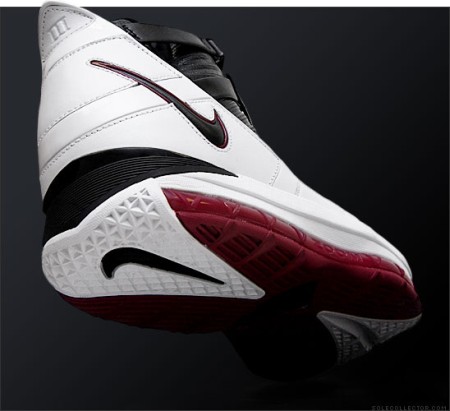 |
|---|
| To the Max: Featuring a multi-chamber full-length large-volume Zoom Air unit surrounded by a cage of strong, but somewhat pliable Pebax, the Zoom LeBron III’s midsole provides a ride with a singular balance of impact protection, cushioning response (i.e. springiness), court feel and stability. Its cushioning alone makes the Zoom LeBron III worth its $125 price of admission. |
Sum up
I think that about covers all the bases – to sum up, the third edition of LeBron James’ signature ride improves on its forebears in a few critical areas. With large-volume Zoom Air units as thick as those employed in the LeBron II, the III delivers equally good impact protection and cushioning response, but with noticeably improved court feel thanks to a slight slimming of its midsole and sockliner. Flexibility at the forefoot has also been improved, helping impart a more natural feel underfoot. And with a higher cut and oversized Pebax support shell, both support and protection for the ankle have been kicked up a notch as compared to either the Zoom LeBron II or Air Zoom Generation. The only significant problem I had with the Zoom LeBron III concerns weight; at 20.8 ounces in a U.S. men’s size 11 the shoe is a good deal heavier than its predecessors, not to mention just about every other hoops shoe on the market today. If you’re a one or lightweight two-guard, this may well be a deal-breaker.
Put in more concrete terms, the Zoom LeBron III is way more shoe than the Steve Nashes and Allen Iversons of the world need. The reason? The shoe was designed specifically for the aforementioned freak of nature, LeBron James. As its designer, Ken Link, explained, the Zoom LeBron III “is not made to be on the market as just another shoe, it’s made so that he [James] can put it on and play in it, and have it live up to his expectations in areas like his amazingly explosive first step.” And, as Link asserts, “We [Nike] don’t do anything different to our shoes that you don’t get on the shelf … I know that when you pick the III up at your local spot, that’s the same shoe LeBron gets, minus he has his name etched on it … it is a lot of shoe, but it’s a shoe that a kid can pick up and play his team ball in, and that’s a big deal because I don’t think a lot of shoes can really withstand the rigors of that.”
I can attest to that last point because the Zoom LeBron III actually performed better after a month’s worth of rigorous testing – fit and comfort were both improved, while feel underfoot remained excellent – than on day one. And outside of some creasing of the upper and midsole along both sides of the forefoot – as well as the usual assortment of scuff marks that accumulate when you actually play ball in your shoes – the LeBron III also held up quite well cosmetically. The only components of the shoe that came out the worse for wear were its laces, which frayed pretty badly along the segments that rubbed against the III’s hard-edged eyestays. Given the extent of the fraying on my test pair, I’d guess that a replacement set of laces would be required inside of three months (at a wear rate of one to one-and-a-half hours per session, four to five times per week), which is within the usable lifespan of the shoe for a non-superhero-sized human being. Granted, laces are cheap and easy to replace, but if they break you’re almost certainly done playing for the day, which is a drag.
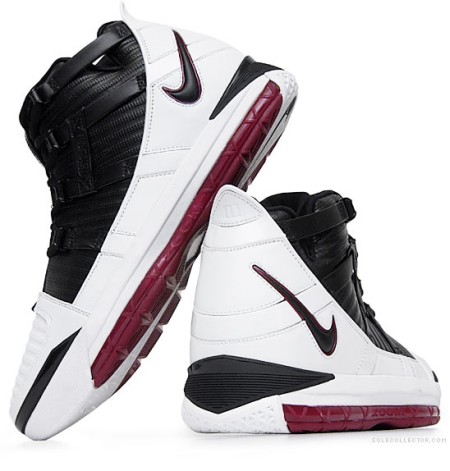 |
|---|
| Power to the People: $125 isn’t chump change, but it’s remarkable how much it gets you in the Zoom LeBron III: a full-length inner-bootie with Sphere lining, a Pebax support shell, full-length Max Zoom reinforced with a Pebax cage, a carbon fiber midfoot shank, and so on. Five years ago this level of shoe tech would have set you back at least $150, most likely more. But the economics of the shoe game have changed and we’re all the beneficiaries. No, the Zoom LeBron III isn’t cheap, but it is a damn good shoe and, dollar-for-dollar, a helluva performance value. |
Still, premature lace-wear notwithstanding, the Nike Zoom LeBron III is quite a remarkable performance value. There’s no question in my mind that, given its technology profile, a shoe like the III would have retailed for at least $150 back during the peak of the signature shoe craze – the days when Shaq was playing for the Association’s other Florida-based squad and eons before a kid from Ohio would be deemed “The Chosen One.” To get full-length large-volume Zoom Air wrapped within a Pebax cage, a carbon fiber midfoot shank, a Pebax support shell, a full-length inner-bootie with Sphere lining and a leather upper in a $125 shoe that, oh, just happens to be designed for the NBA’s biggest ticket is nothing short of astounding. No, the Zoom LeBron III is not cheap, but you’re getting a hell of a lot of shoe for your money.
Conclusion
Yet, with all that being said and as terrific a value as I believe it to be, whether or not LeBron James’ latest signature ride is the right shoe for you really boils down to the, er, weight you place on weight. If it’s a critical criterion – meaning that it’s among the top three things you look for in a hoops shoe – the LeBron III is simply not for you. If, on the other, your key priorities are overall protection and all-around playability, I believe that you may well come to view the Zoom LeBron III as the best shoe you’ve ever balled in. Certainly, it’s not for everyone (present company included), but for some it may well be the one.
by Professor K.
NikeLeBron.net Breakdown
| Comfort & Fit: |
         
|
9.5 |
|---|---|---|
| Cushioning: |
         
|
9.5 |
| Traction: |
         
|
9 |
| Stability: |
         
|
9 |
| Ankle support: |
         
|
9.5 |
| Weight: |
         
|
7 |
| Durability: |
         
|
7.5 |
| Ventilation: |
         
|
7.5 |
| Overall: |
         
|
8.5 |
Other Reviews


